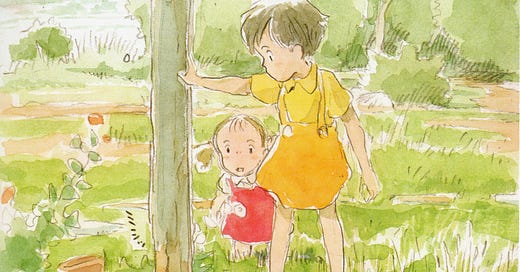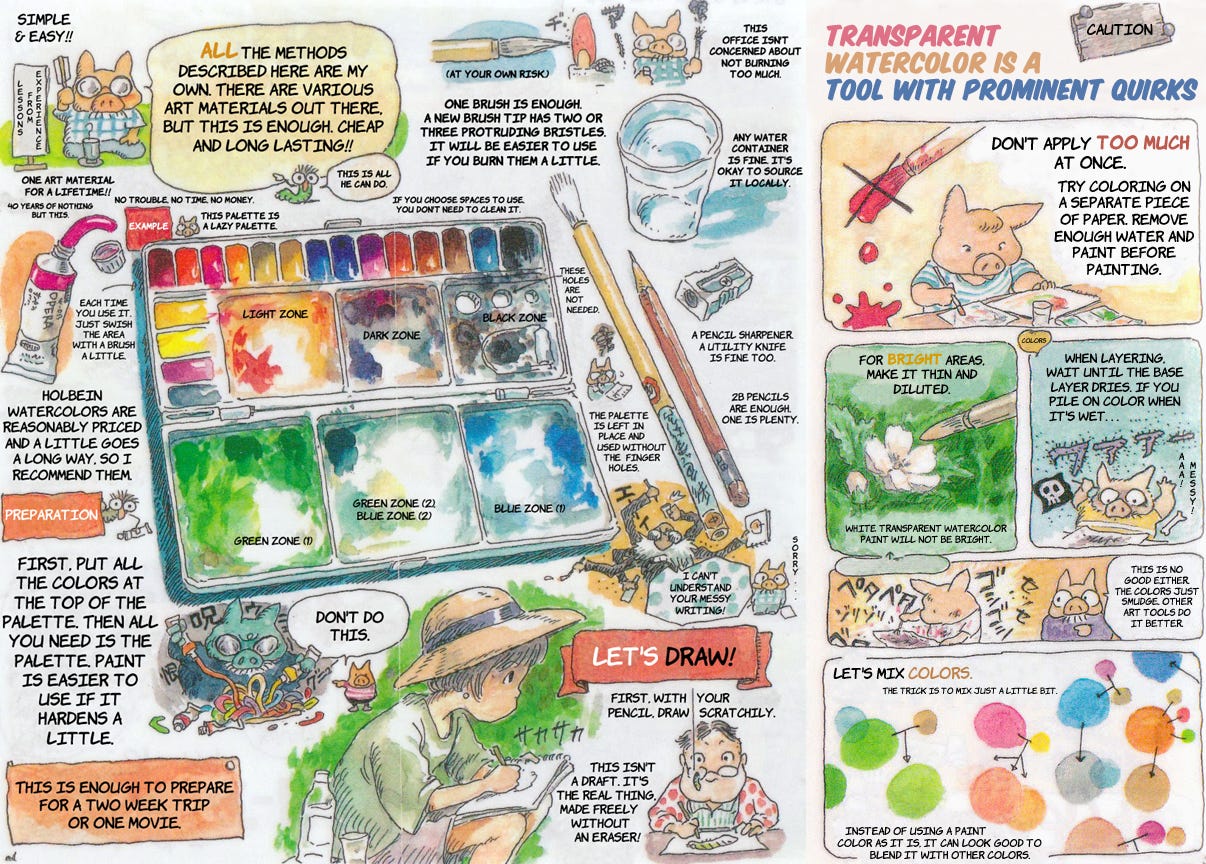Happy Thursday! This issue of the Animation Obsessive newsletter is a little different from the norm. We’re looking at a small guide to painting — written and drawn by Hayao Miyazaki.
If you’ve seen Miyazaki’s watercolor works, like the one above, you already know how amazing they are. He has the power to turn scribbly pencil lines and splotches of color into vibrant sketches that feel actively, restlessly alive. He’s been drawing this way since at least the ‘70s — he’d already done it for years by the time of Future Boy Conan (1978).
So, when Miyazaki took a moment to describe his methods, people were naturally excited.
Back in the 2000s, the Ghibli Museum in Mitaka began selling a “sketch set” with an unbeatable hook: it gave you Miyazaki’s art tools. Plus, it came with a little foldout in which Miyazaki explained how to use watercolors, and how he uses them.
If you can find an unopened one, the original kit contains a pencil, a brush, a pencil sharpener, a sketchbook and a palette — alongside 24 Holbein watercolor paints selected by Miyazaki. Children and people brand new to watercolors were the target audience. The guide by Miyazaki is funny, friendly and self-deprecating, with a number of tips aimed at beginners.
But he also sheds light on his own, idiosyncratic way of working, which is why this foldout has spread online over the years. The classic Ghibli Blog was sharing pictures as far back as 2015. Today, we’re going through a rough new English version of it — and seeing what secrets Miyazaki reveals within.
What Miyazaki makes clear throughout the guide is that he is, proudly, a cheapskate who isn’t fussy about tools. He looks for reliability and convenience. His pitch for Holbein paints is just that they’re “reasonably priced and a little goes a long way.”
(It brings to mind the attitude of Studio Ghibli’s famous painter Kazuo Oga, who’s known to favor low-grade paints in his work.)
In his notes, Miyazaki purposely leans into sounding old and stuck in his ways. He rants about how he’s painted with nothing else for 40 years, how easy and cost-effective his tools are — and then he undermines himself by suggesting that, really, this is all he knows how to do.
Even so, the approach he outlines feels real, lived-in and practical. He mentions singeing the tips of his brushes with a lighter to eliminate stray bristles (and jokes that he doesn’t stress about burning too much). He recommends squeezing paint onto the palette and leaving it there, to avoid the hassle of messing with the tubes. And he shows how he lays out paints to minimize cleaning.
One of his most fascinating notes deals with his pencil sketching. Drawing freely and “scratchily” (シャカシャカ), he treats each line as part of the final piece. There’s no eraser involved — and, understandably, no eraser included in the kit.
Then there’s the simple stuff, like creating highlights by going thin and diluted, rather than using white watercolor paint. He warns against layering too heavily — noting that you’re better off using another medium (oil paints, for example) to do that. His goal is to help newcomers avoid muddiness, the mortal enemy of watercolors.
Miyazaki puts on no show of being a master in his guide. He takes a jab at his own handwritten notes, and one character wonders aloud about the quality of his painting. In response, Miyazaki has the Mitaka mascot character Poki protest (a little too much) that the looseness is a style rather than a sign of poor craftsmanship.
Nevertheless, the skill and taste on display are obvious, and second to none. Miyazaki has a superhuman ability to put life into the very roughest doodles. The look and feel is always, deceptively, effortless.
To give readers an idea of what’s possible with the kit, Miyazaki added two concept sketches that he made with the tools inside. Although his notes don’t say this, the art came from his famous Let’s Eat at Home commercials for House Foods, which aired in Japan between June and August 2003. They were his first time directing “a pure commercial for a general company,” per Ghibli.1
The Let’s Eat at Home spots are a beautiful, nostalgic trip back to ‘50s and ‘60s Japan — done with the help of computer effects that still look impressive today. But they all started from Miyazaki’s rough little sketches. The two compositions shown in the foldout appear in the ads, with the same energy that Miyazaki’s pencil and brush first imbued into them on paper.
The real takeaway from this whole guide might be that, as in the case of Kazuo Oga, the tools aren’t as important as they may seem. Miyazaki uses the stuff he uses because it’s straightforward. It stays out of his way — allowing him to focus on the work.
Which is a valuable lesson in itself.
It seems fitting to close out today’s issue with Miyazaki’s House Foods ads. They originated from tools so simple that the Ghibli Museum sold them to kids. And yet those concept sketches, and the animation they made, stand with the best:
That’s our story today! Thanks for taking a look.
Glancing back at this past month, we find ourselves really happy with our January issues. Most of them had been on the drawing board for a while — in some cases, since 2021. The workload was no joke, but we feel it more than paid off:
On Jiří Barta’s stop-motion classic The Pied Piper (members)
A look inside The Hand by Jiří Trnka (members)
We’ve got big things planned for February, too — including an issue (and translation project) we’ve been working on since September 2022. Stay tuned.
Until next time!
From the entry on Miyazaki’s House Foods ads in the Ghibli ga Ippai Special Short Short booklet.






Love that you explore different drawing styles as animations. Big fan of anime!
Really awesome share and take, cool to see English versions